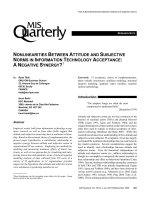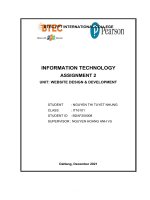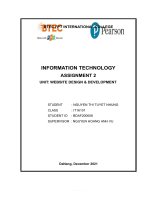information technology assignment 1 unit database design development
Bạn đang xem bản rút gọn của tài liệu. Xem và tải ngay bản đầy đủ của tài liệu tại đây (1.82 MB, 20 trang )
<span class="text_page_counter">Trang 1</span><div class="page_container" data-page="1">
<b>BTEC FPT INTERNATIONAL COLLEGE</b>
<b>INFORMATION TECHNOLOGYASSIGNMENT 1</b>
<b>UNIT: DATABASE DESIGN & DEVELOPMENT</b>
<b>STUDENT: PHAM PHU LOC CLASS: IT05102STUDENT ID: BD00053SUPERVISOR: VO DUC HOANG</b>
<b>Da Nang, October 2022</b>
</div><span class="text_page_counter">Trang 2</span><div class="page_container" data-page="2"><b>ASSIGNMENT 1 FRONT SHEET</b>
<b>Unit number and titleUnit: Database Design & Development</b>
<b>Submission date10/11/2021<sup>Date received (1st</sup></b>
<b>Student declaration:</b>
I certify that the assignment submission is entirely my own work and I fully understand the consequences of plagiarism. I understand that making a false declaration is a form of malpractice.
<b>Student’s signature:Phu Loc</b>
<b>Grading grid:</b>
</div><span class="text_page_counter">Trang 3</span><div class="page_container" data-page="3">❒<b>Summative Feedbacks: </b>
❒
<b>Resubmission Feedbacks:</b><b>Internal Verifier’s Comments:</b>
<b>Signature & Date:</b>
</div><span class="text_page_counter">Trang 4</span><div class="page_container" data-page="4"><b>TABLE OF CONTENT</b>
<b>INSTRUCTOR/ SUPERVISOR/ ASSESSOR ...i</b>
<b>REVIEWERS ... iv </b>
<b>TABLE OF CONTENT ... ix </b>
<b>LIST OF TABLES AND FIGURES ... xi </b>
<b>LIST OF ACRONYM ... xii </b>
<b>INTRODUCTION ... 1 </b>
CHAPTER 1: DESIGN DATABASE... 2
1. Use an appropriate design tool to design a relational database system for a substantial problem(LO1)...2
1.1 Design a relational database system using appropriate design tools and techniques,containing at least four interrelated tables, with clear statements of user and system requirements.(P1) … 21.1.1The scenario of the chosen system... 2
1.1.2System Requirement Specification (SRS)... 3
1.1.3Logical design (ERD)... 4
1.1.4Explanation... 5
1.1.5Physical design... 6
<b>CRITICAL EVALUATION ... 15 </b>
<b>CONCLUSION...16</b>
</div><span class="text_page_counter">Trang 5</span><div class="page_container" data-page="5"><b>LIST OF TABLES AND FIGURES</b>
Figure 1.1-1: FPT school...2
Figure 1.1-2: Student Management System...3
Figure 1.1-3: Entity Relationship Diagram...4
Figure 1.4-4: Physical design...7
Figure 1.2-1: Login - Student Management System...7
Figure 1.2-2: Home - Student Management System...7
Figure 1.2-3: List - Student Management System...8
Figure 1.3-1: User and system requirements...14
Table 1.2-1: Major Data...8
Table 1.2-2: Course Data...8
Table 1.2-3: Student Data...9
Table 1.2-4: Study Program Data...9
Table 1.2-5: Study Program Data...9
Table 1.2-6: Result Data...10
Table 1.2-7: Result Data...10
Table 1.2-8: Class Data...10
Table 1.2-9: Unnormalized Example...11
Table 1.2-10: First normal form (1NF) Example...12
Table 1.2-11: Second normal form (2NF) Example...12
Table 1.2-12: Second normal form (2NF) Example...13
Table 1.2-13: Third normal form (3NF) Example...13
Table 1.2-14: Third normal form (3NF) Example...14
</div><span class="text_page_counter">Trang 6</span><div class="page_container" data-page="6"><b>LIST OF THE ACRONYM</b>
</div><span class="text_page_counter">Trang 7</span><div class="page_container" data-page="7">First of all, I would like to thank my mentor Vo Duc Hoang for his constant support in mystudies and research, for his patience, motivation, enthusiasm and rich knowledge. Without yourwonderful help, I would not have been able to achieve this.
In addition to my mentor, I would like to thank my friends who have helped me improve myknowledge of my subject. And besides, I would like to thank the school for creating all conditionsfor me to have adequate facilities to help me complete my work.
Last but not least, I would like to thank my family: my parents Pham Phu Loc and Phan ThiThu. They are always behind to care and help me have more motivation to complete the work well!The network plays a very important role in life.
From there, we will test the results that we have done. Finally, we will operate the systemand maintain it. It is also a process to build a complete Database Design & Development system.Let's find out in this assignment!
1.Use an appropriate design tool to design a relational database system for a substantialproblem (LO1)
1.1 Design a relational database system using appropriate design tools and techniques, containing at least four interrelated tables, with clear statements of user and system requirements. (P1)
</div><span class="text_page_counter">Trang 8</span><div class="page_container" data-page="8"><b>CHAPTER 1: DESIGN DATABASE</b>
<b>1. Use an appropriate design tool to design a relational database system for asubstantial problem (LO1)</b>
<b>1.1Design a relational database system using appropriate design tools and techniques, containing at least four interrelated tables, with clear statements of user and system requirements. (P1)</b>
<b>1.1.1 Scenario of the chosen system</b>
Figure 1.1-1: FPT school
- For a big IT consulting firm, you are a Database Developer. The FPT University hasapproached the firm and is expanding due to the increase in the number of students. FPT hasdifficulty interacting with university management at the moment.
- It chose to build various academic systems that would make the institution simpler toadminister, such as: the online library, the student graduation system, the attendance system, theCMS system.
- You are responsible for selecting one of the systems for developing the FPT universitydatabase. Your responsibilities are:
Work with FPT to learn about existing system needs
Analysis needs and makes unambiguous user and system requirements statements.Conceive a relational database system utilizing design tools and processesDevelop a completely working relation database system based on the system design
</div><span class="text_page_counter">Trang 10</span><div class="page_container" data-page="10">- Currently, FPT University has many discrete and inconsistent management systems suchas: Online Library system, Student Grading System, Attendance System, CMS System, SchedulingSystem, Enrolment Systems, and so on.
- Thus, it is time for us to create a unified system to effectively capture and managestudents in teaching and school management.
<b>- Therefore, we have proposed to build a “Student Management System” - a large system</b>
with a large source of data so that FPT University can thoroughly solve these difficult problems.
<b>1.1.2 System Requirement Specification (SRS)</b>
- The creation of the FPT relationship database and division into clear and accurate tabulations cansolve all of the difficulties listed above:
<b>+ Major: Each Major has a major identity,</b>
the main name, and the foundation year.
<b>+ Courses: every course has a course</b>
management code, the year beginning, and theyear ending.
<b>+ Student: Every student has a student</b>
identity and belongs to a certain class identity(identified by ClassID).
<b>+ Program: Each program has a managing</b>
code and a name for the program.
subject: Each subject has a management code and belongs to a certain discipline (identified by
major). Figure 1.1-2: Student Management System
<b>+ Subject: Each subject has a management code and belongs to a certain discipline</b>
(identified by MajorID).
<b>+Result: Each result of the exam records a student who took the test for a specific topic </b>
during a certain test period. (The student can take more than once a specific topic).
<b>+ Lecturer: Each line in this table indicates a subject taught in a particular discipline within a</b>
certain program. In this program, that subject is specified with a specific number of theoretical andpractical periods and equivalent to how many credits. (The number of credits includes boththeoretical and practical credits).
<b>+ Class: A class that has a class code to manage, belongs to a certain industry and is open to</b>
a certain course, in a certain program. The ordinal numbers are numbered in ascending order forclasses of the same course, major, and program.
</div><span class="text_page_counter">Trang 11</span><div class="page_container" data-page="11">study programs, classes, lectures,... Along with that is the data retrieval at the request of users.
This system has high security to avoid data loss,...
Correct transaction actions are stored, and the system records the modifications and cancellations.
Nice and easy to use external interface.
The system stores data history for users to easily check and review.
<b>- Non-functional requirements:</b>
There are no problems and the system operates stably 24/7 and high performance.For instance, re-response time is within 1-2 seconds as well as throughput.The system also have a scalability.
It also contains many data and is quite reliable.
Stable resilience and maintenance and excellent interoperability.
</div><span class="text_page_counter">Trang 12</span><div class="page_container" data-page="12">Figure 1.1-3: Entity Relationship Diagram
</div><span class="text_page_counter">Trang 13</span><div class="page_container" data-page="13"><b>For the system, Reasons ERD is suitable because:</b>
- The relations of entities recorded in the database is shown in an Entity RelationshipDiagram (ERD). An entity is an object, a data component in this context. A collection of relatedentities is a set of entities. They may have characteristics that identify their characteristics.
- The ER diagram shows the logical structure of databases by defining the entities, theircharacteristics and displaying their relations.
- Because the system requires a relational database to be designed. The tables are tightly connected according to the ERD graph. The system may simply and conveniently provide statistics on student data, and topics. Easily and scientifically import and export data, thus ERD is a good choice.
</div><span class="text_page_counter">Trang 14</span><div class="page_container" data-page="14">an ERD diagram:
A smooth underline is the primary key.
Foreign keys are not seamless, specified with underscores. Table 1.1-1: tblStudent
Field name Description Type Length
Table 1.1-2: tblCourse
<b>Field NameDescriptionTypeLength</b>
Table 1.1-3: tblStaf
<b>Field NameDescriptionTypeLength</b>
Table 1.1-4: tblStaf_Department
<b>Field NameDescriptionTypeLength</b>
</div><span class="text_page_counter">Trang 15</span><div class="page_container" data-page="15">Table 1.1-5: tblProject_Transaction
<b>Field NameDescriptionTypeLength</b>
Table 1.1-6: tblStudent_Registration
<b>Field NameDescriptionTypeLength</b>
Registration Date Date
</div><span class="text_page_counter">Trang 16</span><div class="page_container" data-page="16">Table 1.1-7: TblStudent_Reports
<b>Field NameDescriptionTypeLength</b>
Transaction Record Int 11
- Next, we need to define 1-n, 1-1, n-n relationships to be able to connect the tablestogether:
In a class that will have many different courses and different majors, this is a 1-n relationship.
Each major will have many subjects such as Program, network, web, and database, ... this is a 1-n relationship.
Each student will have many learning outcomes from many different subjects, thisis a 1-n relationship.
Each lecturer can only teach one subject and a certain course, this is a 1-to-1relationship.
Each major will have a specific program of study for that discipline, this is a 1-to-1relationship.
Each course will have many different subjects for each course and each subject, thisis an n-n relationship.
<b>1.1.5 Physical design</b>
- The materialization of a database in an actual system is a physics-based concept. Althoughlogical design may be done regardless of the ultimate data base platform, many physical databasefeatures are reliant on the details and semanticity of the DBMS target.
+ Conversion of the logical design in table definitions: pre-deployment designs, tabledefinitions, standardization, primary and external key relations, fundamental indexing.
+ Physical data database design after deployment, frequently carried out by a
</div><span class="text_page_counter">Trang 17</span><div class="page_container" data-page="17">Figure 1.4-4: Physical design
</div><span class="text_page_counter">Trang 18</span><div class="page_container" data-page="18"><b>CRITICAL EVALUATION</b>
After completing this assignment with my own efforts and with the help of my mentor.During the learning process, he was very dedicated to teaching and always answered my questions.With the knowledge that I have learned, I have presented very fully the questions that Assignmentraised in brief, with clear and specific images. Moreover, I am confident that I can self-study and can make the Database Design & Development process for business.
In addition, I have mastered the basics of Database Design & Development, so I candefinitely create a large Database Design & Development to help many people connect with each
</div><span class="text_page_counter">Trang 19</span><div class="page_container" data-page="19">After completing this report, I have understood and grasped the principles, analysis and specification of a Database Design & Development system and their operation. Moreover, with Microsoft SQL Management System software, I can use it to design, and code a complete database to be able to develop a website or application.
I am now confident that I can select the necessary devices and build the development anddatabase management workflows that are right for me.
Database Design & Development is really great! Thanks to it, I understand how the devices
</div><span class="text_page_counter">Trang 20</span><div class="page_container" data-page="20">








